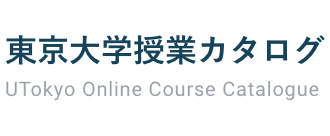過去(2023年度)の授業の情報です
学内のオンライン授業の情報漏洩防止のため,URLやアカウント、教室の記載は削除しております。
最終更新日:2025年4月21日
授業計画や教室は変更となる可能性があるため、必ずUTASで最新の情報を確認して下さい。
UTASにアクセスできない方は、担当教員または部局教務へお問い合わせ下さい。
最終更新日:2025年4月21日
授業計画や教室は変更となる可能性があるため、必ずUTASで最新の情報を確認して下さい。
UTASにアクセスできない方は、担当教員または部局教務へお問い合わせ下さい。
物理化学基礎II
(岩崎)レーザーの科学や超高速レーザー分光法について,最近の実験的理論的発展を引用することによって,光源技術から先端計測方法、およびその科学について基礎から講義する.
(Iwasaki) This course aims to introduce laser science and ultrafast spectroscopic methods by referring to the recent advances in experimental and theoretical methods in light sources, measurements and their sciences.
(加藤)近年の極超短・強レーザーパルス発生技術の進歩に伴って実験的に実現されてきた強光子場科学分野の実例から,量子動力学理論の必要性を理解する.そして,現在,量子化学の分野では,どのような理論的枠組みが,どのような原理に従って構築されているのかを各理論の関係性と共に理解する.
(Kato) We will understand the necessity of quantum dynamics theory from examples in the field of strong photon field science that have been experimentally realized with recent advances in ultrashort and strong laser pulse generation technology. Then, in the field of quantum chemistry, we will understand what kind of theoretical framework is constructed according to what kind of principle, together with the relationship between each theory.
(Iwasaki) This course aims to introduce laser science and ultrafast spectroscopic methods by referring to the recent advances in experimental and theoretical methods in light sources, measurements and their sciences.
(加藤)近年の極超短・強レーザーパルス発生技術の進歩に伴って実験的に実現されてきた強光子場科学分野の実例から,量子動力学理論の必要性を理解する.そして,現在,量子化学の分野では,どのような理論的枠組みが,どのような原理に従って構築されているのかを各理論の関係性と共に理解する.
(Kato) We will understand the necessity of quantum dynamics theory from examples in the field of strong photon field science that have been experimentally realized with recent advances in ultrashort and strong laser pulse generation technology. Then, in the field of quantum chemistry, we will understand what kind of theoretical framework is constructed according to what kind of principle, together with the relationship between each theory.
時間割/共通科目コード
コース名
教員
学期
時限
35606-0049
GSC-CH5108L3
物理化学基礎II
岩崎 純史
火曜2限
講義使用言語
英語
単位
1
実務経験のある教員による授業科目
NO
他学部履修
可
開講所属
理学系研究科
授業計画
(岩崎)
1. 光と物質の相互作用
2. レーザーによる超高速過程の観察
3. レーザーパルスの発生と伝搬
4. 高強度中の原子分子の科学
(Iwasaki)
1. Interaction between light and matter,
2. Observing ultrafast chemical processes by laser pulses,
3. Generation of laser pulse and propagation,
4. Atoms and molecules in Intense laser field
(加藤)
1. 強光子場科学とは―電子ダイナミクス・分子ダイナミクス-
2. 時間依存Hartree-Fock理論
3. 時間依存配置間相互作用理論
4. 多配置時間依存Hartree-Fock理論
5. 時間依存の有効ポテンシャル理論
6. 密度方程式理論
7. 密度汎関数理論
8.波動関数理論と密度汎関数理論の関係性
(Kato)
1. What is strong field science? Electron dynamics, Molecular dynamics
2. Time-Dependent Hartree-Fock theory (TDHF)
3. Time-dependent configuration interaction theory
4. Multi-Configuration Time-Dependent Hartree-Fock theory (MCTDHF)
5. Time-dependent effective potential theory
6. Density Equation Theory (DET)
7. Density Functional Theory (DFT)
8. Relationship between wave function theory (WFT) and density functional theory (DFT)
授業の方法
(岩崎)
(加藤)講義形式,スライドを中心に授業を進める.必要に応じて,板書を用いて詳細説明や質疑応答を行う.また,重要な点の理解を確実にするため,講義時間内に何題か小問題を出題し,受講生にその場で解答を作成してもらう.解答作成の後,問題の解説を行うことで理解を深める.
(Kato) The class will be in a lecture format, using slides. If necessary, detailed explanations and questions and answers will be given using the blackboard.
In addition, in order to ensure the understanding of important points, small questions will be given during the lecture time.
成績評価方法
出席とレポートの結果をもとに判断します.
Grades will be evaluated based on the reports and attendance.
Only those who submit TWO reports (to Iwasaki and Kato) will be evaluated.
教科書
(岩崎)使用しない.適宜講義資料を配布する.
(Iwasaki)A textbook will not be used. Handouts will be distributed.
(加藤)特に定めませんが,より詳しく学習したい場合には適宜聞いてください.
(Kato)Not specified in particular. If you want to study in more detail, please ask me.
参考書
(岩崎)使用しない.適宜講義資料を配布する.
(Iwasaki)A textbook will not be used. Handouts will be distributed.
(加藤)特に定めませんが,より詳しく学習したい場合には適宜聞いてください.
(Kato)Not specified in particular. If you want to study in more detail, please ask me.
履修上の注意
(加藤)量子化学の基礎的な知識を必要とします.数式が多く出てきますが,受講中は,その詳細よりも各理論間の関係性を理解するように努めて下さい.
(Kato)Basic knowledge of quantum chemistry is required. There are many mathematical formulas, but please try to understand the relationship between each theory rather than the details during the course.
その他
e-mail:
(Iwasaki) *****
(Kato) *****





 大学院
大学院

 マイリストに追加
マイリストに追加
 マイリストから削除
マイリストから削除


